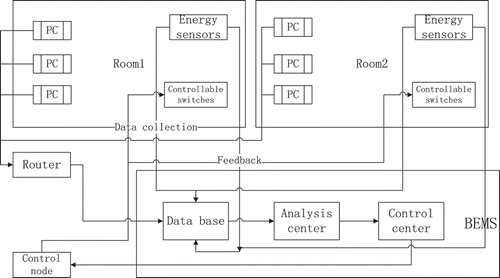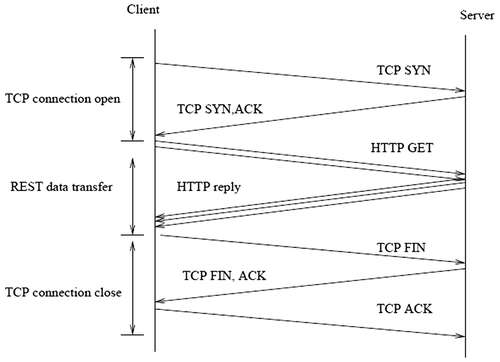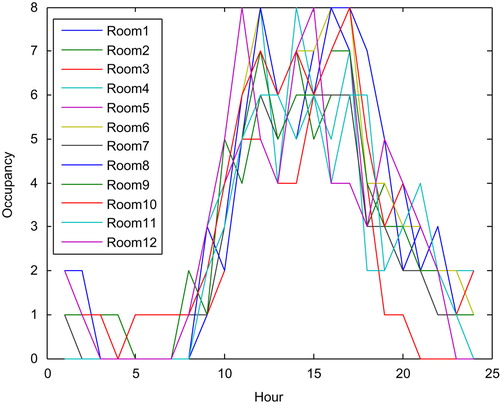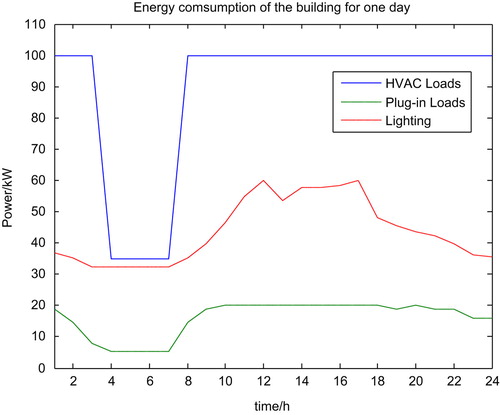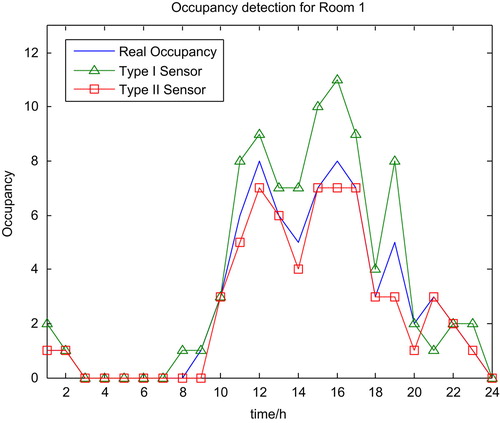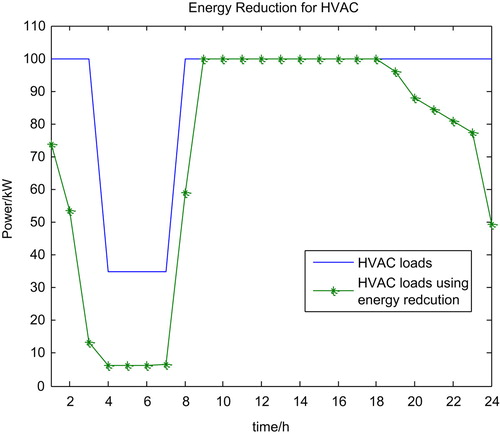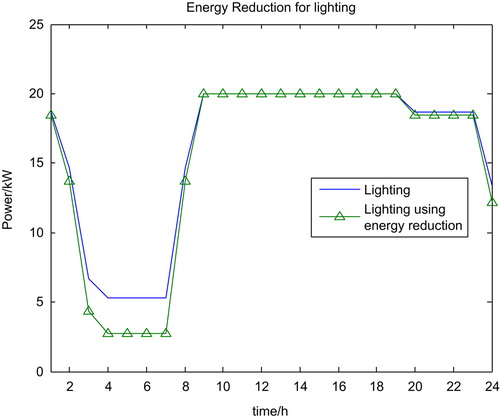Abstract
To meet environmental-friendly requirements, Building Energy Management Systems (BEMS) is required for energy consumption monitoring and management. A new energy reducing strategy based on BEMS is proposed in this paper. First, the concept of BEMS monitoring is presented and the communication protocol of BEMS is discussed. Then, implicit occupancy detection method is used to calculate the number of people in the building. This method, which is largely based on existing IT infrastructure that already installed for non-energy purpose, can gather data inexpensively and has a high accuracy compared with traditional method. Finally, the strategy for energy reducing is proposed based on the occupancy data. Building electric devices like HVAC, lighting are monitored and controlled to improve building functionality and reduce energy. Simulation based on MATLAB is carried out to test the implicit occupancy method and energy control strategy. The result shows that the methods have a significant effect on reducing the energy consumption of the building.
1. Introduction
Today, building energy consumption takes a great part of total energy consumption in the world. To meet environmental-friendly requirements, Building Energy Management Systems (BEMS) is developed for energy consumption monitoring and management. By monitoring and control the energy consumption within a building, BEMS can reduce energy consumption and provide a better efficiency.
BEMS is designed to achieve these four goals [Citation1]:
Detects abnormal energy utilization.
Adjust the running strategies of devices.
Ensure a comfortable indoor environment.
Eliminate energy loss.
There are many energy modules in building, such as HVAC system, lighting system, elevators and office equipment, etc. Taking optimization control of equipment can reduce total energy consumption in a very significant level. Plenty of effective tests have been done by literature and the advantages of taking use of BEMS system have been proved. However, there are still some drawbacks for current BEMS systems. Generally speaking, the bottlenecks of BEMS system include the high-cost of sensors, data collection, and inaccurate occupancy estimation.
For most BEMS, reinstallation of large amount of energy sensors is required for the monitoring system. Each sensor costs a lot. In this paper, we try to reduce new sensor installation as much as possible. We take use of the existing monitoring equipment and cooperate with computer networks to use fewer sensors. Moreover, the data information communication requires efficiency and accuracy. It is very difficult to meet these requirements even if using wired communication. We applied RESTful Web services on an IP-based multi-hop low-power sensor networks in order to improve the effective communication between sensors, controllers and BEMS database. Based on [Citation2], turning on the sensor radio only during the information sending time will save energy when communicating in public building. Also, occupancy estimation is not intelligent enough in some literature by detecting whether the door is open or not in one room. In this paper we estimate the occupancy by detecting the wireless networking access by individual computers and the motion of mouse and keyboard. Although this method is still not extremely accurate in case someone not using computer in the room, it is advanced than many other monitoring methods.
The overall BEMS structure proposed in this paper is illuminated as . Take two rooms in one zone as example. Each room has energy sensor and controllable switches independently. These two rooms in one zone share one router and a control node together. When personal computers (PC) connect internet through wireless network, the router records the IP address of each computer. Routers and energy sensors send required information data to the BEMS central database when they receive a specific order. BEMS system analyzes the occupancy and energy saving strategy based on our algorithm and techniques, then sends order to control node in each zone by control center through our wireless communication method. After adjusting by controllable switches in each room, the energy sensors are required to send feedback information to BEMS database again in order to take further actions.
This paper is organized as follows. Section 2 outlines BEMS monitoring system. A communication protocol is discussed in Section 3. Section 4 introduces occupancy detection algorithm using implicit occupancy detection. Energy reduce strategy is highlight in Section 5. Simulation and result analysis is in the following Section 6. Finally, brief conclusion is given in Section 7.
2. BEMS monitoring
Acquiring temperature, humidity, illumination intensity and the amount of energy consumption is very important in Building energy management system. This part of operation is called monitoring. The goals of BEMS monitoring is basically illuminated by the following four parts [Citation1]:
Improve building management.
Find inefficient equipment.
Identify abnormal energy consumption.
Decrease peak electrical demand.
To achieve these four purposes, sensors and controllers are required for different usages.
2.1. Sensors
Sensor networks are seen as the first layer operation in the emerging fields of energy management. Those sensors are used to detect environment condition and energy consumption, such as lighting, temperature, humility, electricity, etc. Generally, most sensors are categorized as:
Thermometer.
Humidometer.
Ambient light sensor.
Door & Window sensor (detecting whether the door/window is open or not).
motion detection sensors(detecting movement in a particular area).
Energy meter (allowing power monitoring).
2.2. Energy controller
Energy Controllers adjust the energy consumption equipment in the particular area based on the order from BEMS control center. The Energy Control function is implemented based on TelosB with a Tyco relay [Citation3].
3. Communication protocol
All the sensors and controllers needs to communicate with BEMS data center and control center. An effective and energy saving communication protocol is necessary to be developed for the BEMS system. A prototype distributed control system for building energy management that uses wireless sensor network-class nodes.
Many existing sensor network deployments use specialized and highly optimized protocols that require the presence of a gateway that connects the sensor network to the outside world. To be able to avoid the use of a specialized gateway, several recent systems use the IP protocol inside the sensor network.
In this paper we take use of a IP-based sensor network system proposed on paper ‘Efficient Application Integration in IP-Based Sensor Networks’. In this system, sensor nodes communicate their information using Web services, allowing direct integration in modern IT systems. To integrate sensor networks with existing IT systems, the use of Web services has been proposed. Such a system must be responsive, intuitive, robust, and scalable.
3.1. Communication system framework
Integrate the Web services mechanism with an off-the-shelf power-saving MAC protocol (X-MAC) [Citation2] and provide important insights into optimizing its use for RESTful Web services.
Two mechanisms are used to provide a good performance and low-power operation: a session-aware power-saving radio protocol and the use of the HTTP Conditional GET mechanism. Web services are a viable mechanism for use in low-power sensor networks.
REST transaction over a multi-hop low-power network typically is completed within fractions of a second, and with a low power consumption. TinyREST, is developed as part of a Home Services Framework. Its goal is to generate a specific REST based approach for the framework rather than providing a generic framework that this work aims for.
3.2. Web services
Web services are a common name for a set of techniques for developing interoperable distributed applications usually using Web-related standards such as HTTP.
A Web services-based sensor network can be integrated into office automation or home energy management systems that are built on standard IT system components. Unlike specialized gateway-based approaches, Web services provide an architecture that is able to evolve as the field grows.
Generally, web service is classified into two classes: SOAP-based Web services and RESTful (or REST-based) Web services. SOAP-based Web services employ Simple Object Access Protocol (SOAP) standard. RESTful Web services use Representational State Transfer (REST). RESTful Web services, a much simpler mechanism than SOAP-based Web services, provide benefits in terms of completion time and power consumption [Citation2].
3.3. Transaction
The transaction consist of three phases: the TCP connection open phase, the REST transaction phase, and the TCP connection closing phase. The structure is illuminated in .
The TCP connection open phase establishes a TCP connection between the client and the server.
The REST transaction phase, which is initiated only if the TCP connection succeeds, is when the actual data is transmitted. Data can be transmitted both from the client to the server or to the client from the server. REST is a software architectural style for distributed systems, which is typically using the standard HTTP request methods. The network transactions used by a RESTful Web service implementation are simple.
Packet loss during the REST transaction phase is handled by the normal retransmission mechanism of TCP. When the REST data has been successfully transmitted, close phase of the TCP connection
The data format in this system is chosen as JavaScript Object Notation, JSON.
3.4. Power-saving MAC protocols
Radio transceiver is the most energy consuming component of a typical sensor node, use power-saving MAC protocol saves energy using communication process in BEMS system.
X-MAC is a low power MAC protocol that uses a sequence of short preambles to wake up the receivers. Nodes wake up for a short time in regular periods to listen for preambles. X-MAC lets the radio be switched on during a TCP connection, and save energy by switching off the radio most of the time and hence reducing idle radio listening [Citation2].
When a node wakes up and receives a preamble addressed to it, it replies with an acknowledgement showing that it is awake. Upon reception of the acknowledgement from the receiver, sender transmits the whole packet.
3.5. Implementation
Independent multicast, sensors and controllers are allowed to efficiently share information in a distributed peer-to-peer fashion. A wireless sensor network (WSN) is used to share this information. Wireless sensor networks utilize low-powered low-cost wireless nodes communicating over an ad hoc network. Standardization is emerging in the form of IEEE 802.15.4 and 6LoWPAN.
The use of IP multicast distributes the responsibility for information sharing to the network rather than either the sensor or controller. The ZigBee Smart Energy Profile 2.0 allows both forms of information sharing [Citation3].
Furthermore, this is implemented at the network layer, redundant packet transmissions can also be eliminated, which improves energy efficiency.
4. Occupancy detection
Because energy consumption is closely tied to occupant behavior, numerous building monitoring systems have been recently developed to provide occupants with detailed energy consumption information.
Occupancy detection in current buildings is typically accomplished using passive infrared (PIR) and ultrasonic motion detectors. These dedicated occupancy sensors are installed expressly to determine occupancy and control building systems to reduce energy. Drawbacks to such explicit occupancy sensing include high cost of installation and use, limited accuracy, incorrect installation, failure after installation (often unrecognized), and lack of networking capabilities for data collection [Citation4].
This paper applies the so-called ‘implicit occupancy sensing’ approach to identify occupancy by using existing IT infrastructure common to many buildings. The occupancy can be estimated from sources not originally intended for occupancy sensing. By using existing infrastructure, occupancy information can be gathered inexpensively and with reduced energy overhead.
The implicit sensor used to determine occupancy information can be classified into three types. Type I sensor requires no modification to existing systems. The typical type I sensors include the Address Resolution Protocol (ARP) and Dynamic Host Control Protocol (DHCP) [Citation4]. ARP is always used by routers to determine the Ethernet or Wi-Fi Medium Access Control (MAC) address of all hosts on a subnet and associate it with the host’s IP address. Routers use the ARP protocol to maintain a table, or ARP cache, of associated IP and MAC addresses to enable forwarding of packets from a router to a host. The ARP table is a measure of the number of active hosts in the local network. ARP data collected from routers and Wi-Fi Access Points (AP) within a building can serve as implicit occupancy measures.
DHCP can be used as a similar measure as ARP of the number of hosts on a network [Citation4]. DHCP is used by non-permanent hosts to lease an IP address for a temporary period of time. A DHCP server has a pool of IP addresses and maintains a table of which addresses are currently leased-out. Thus, the DHCP lease data is a measure of the number of active hosts on the network not including the hosts with fixed IP addresses, typically servers). In wireless networks the majority of (if not all) hosts use DHCP to obtain an IP address. Additional measures related to DHCP include the number of new hosts, the number of hosts which hop between wireless access points (APs), and the number of hosts whose leases have expired. These DHCP measures may relate to occupancy measures of people entering the building, moving within the building, and leaving the building within the last DHCP timeout period.
Type II sensor includes the addition of software to existing infrastructure to make existing occupancy related data available. The most widely used type II sensor is Wi-Fi devices. Wi-Fi can be used to locate occupants in a building where software on user hosts report all the available APs and their respective signal strengths. Another indication of occupancy is keyboard and mouse use. Operating systems provide functions to detect input activity but additional software is needed to collect this activity and make it available remotely. This information is made available remotely using the Simple Network Management Protocol (SNMP). SNMP provides a standard way to centrally gather the information recorded by the PC Activity Monitor on various computers. Since employees always spend most of their time in their private office where their PCs are located, monitoring computer activity would be a good predictor of total building occupancy.
Type III involves the addition of software and hardware to introduce new sources of occupancy data to existing systems. This kind of sensors could be used, for example, for measuring environmental conditions (temperature, etc.) as a measure of occupancy.
Implicit sensing can provide additional information about the occupants such as activity and identity. Different types of sensors have different accuracy level. In this paper, we use DHCP and mouse and keyboard as type I and II sensors to identify the occupancy number of the building, use type III sensor to get the temperature of the environment so that the energy consumption of HVAC devices can be controlled.
5. Energy reduce strategy
The BEMS analysis center provides an approach to reduce the energy consumption as well as ensure a comfortable indoor environment. Database collects necessary information from different sensors by detecting abnormal energy utilization and energy-consumption equipment operation. Then send orders of adjust running equipment to each specific controllers after analysis the data based on the following optimization strategy.
5.1. HVAC
HVAC is abbreviated for heating, ventilation, and air conditioning. Taking optimization control of HVAC equipment will reduce energy consumption significantly.
The control strategy of HVAC system is listed following [Citation5].
Using variable-air volume systems with variable speed fans. By taking this action, energy consumption can be reduced for off peak time.
Separating the ventilation from the heating and cooling functions. In this case, heated or cooled air will not be wasted during ventilating.
Implementing a demand-controlled ventilation system in which ventilation airflow changes with changing building occupancy.
Allowing the temperature maintained by the BEMS system to vary seasonally with outdoor condition.
Re-circulate 80% of the internal air in HVAC system on each circuit and replace only 20% with fresh outside air. Take use of the heated/cooled air mostly.
The temperature shall begin to be reduced/increased automatically with 3 degrees every15 min in one zone without occupancy.
The ‘central off’ function shall be automatically activated whenever there are no people in the room for a time period more than 20 min.
HVAC automatically stops if one window or the door is open for more than 5minutes. The door and window sensor should push information to BESM control center if any open door/window have been detected.
5.2. Lighting
Apart of HVAC, another huge energy consumption equipment in large public building is lighting systems. The energy saving strategy for this part is listed below [Citation5].
Use of efficient lighting systems by change efficient lighting devices (ballasts, lamps, luminaries) which can reduce energy consumption even if without energy saving control.
An efficient lighting system requires separate controls for different lighting zones or even in each room.
In corridors and parking area, lighting has to work with 30% capacity normally. If somebody enters, lights turn to 100% automatically by motion detection sensors.
5.3. Others
Personal computers, monitors, printers, photocopiers, facsimile machines, etc., is foreseen to be selected by the lowest power demand and on ‘energy saving’ features.
To save power, sensor nodes must switch off their radios as soon as response the BEMS center service.
5.4. Energy reduction estimation
The effective energy reduce tests have been pursued by other papers. Based on [Citation5] the following conclusions can be derived.
Reduction of the room temperature by 1 °C in heating system can reduce the consumption of heating energy by 6%.
Eighteen per cent of the heating energy could be saved in a non-occupied room by switch off the HVAC system.
Day lighting can provide 40–80% savings in lighting energy use in perimeter offices.
6. Simulation
Assume there is a building with 12 rooms, shown as . The occupancy for each room in one day is shown in .
The power of different kinds of devices, i.e. HVAC loads, lighting and plug loads, is shown in . The energy consumption of the building in one day is shown in .
Table 1. Power of different devices in the building
6.1. Occupancy detection
Identify the number of people in each room using implicit occupancy sensing method. Two types of sensors are used: type I sensor as DHCP, type II sensor as keyboard and mouse usage.
Three kinds of errors are set for type I sensors: overlap of Access Point (AP) coverage, devices losing network presence, and mobile phones that can provide an extra Wifi connection. The type II sensors also have the possibility to was prone to false negatives indicating that the space is in use while the PC mouse and keyboard were not.
The simulation result in room 1 is illustrated as .
The result shows that both type I and type II sensors can reveal the occupancy in the room. However, their accuracy is different. Type I sensors have a high accuracy in detecting the non-occupancy status. Type II sensors, in the contrary, have a high accuracy in detecting the occupancy status of a room. As a result, it is better to use the type I sensing result as an indicator for the control strategy of electric loads in the building.
6.2. Energy saving method
With occupancy detection results, the energy consumption in building can be saved. The strategy used for saving HVAC loads and lightings is in chapter V. The results are shown in Figures and .
It can be seen that HVAC loads are turned off when there is no person in the rooms. When outdoor temperature changes, the temperature set shall be not more than 7 grade degrees up or down compare the outside temperature.
The lighting energy consumption can also be reduced. In corridors and public area, lighting can work with 30% capacity on work hours. If some body enters, lights go on 100% automatically controlled by motion detection sensors.
As a result, the total energy saving for one day of the building is 10.22%.
7. Conclusions
In this paper a BEMS system that combines different advanced technology including effective sensor, energy saving communication, accurate occupancy detection and energy reduce strategy is proposed. The BEMS is developed for improving energy efficiency and cutting down energy consumption by taking optimized control based on building monitoring. Simulation results show the efficiency and practical of the proposed system and methods.
Disclosure statement
No potential conflict of interest was reported by the authors.
Funding
This work was supported by State Grid Corp science and technology project ‘Distribution system operational efficiency monitoring and analysis based on big data’ [grant number B3441316K005].
Notes on contributors
Xianing Jin (1985–), female, received the PhD degree in Electrical Engineering from Tsinghua University in 2013. She is a senior engineer in State Power Economic Research Institute. Her research interests include distribution system planning, reliability analysis and lean management of power systems.
Guanqun Wang (1985–), male, received the PhD degree in Electrical Engineering from Tsinghua University and Washington State University in 2012 and 2016, respectively. He is a staff engineer in Burns & McDonnell, Houston, Texas, U.S.A. His research interests include PMU-based power system stability analysis, transmission & distribution planning and grid modernization.
Yi Song (1977–), male, received the PhD degree in Electrical Engineering from TianJin University in 2008. His research interests include distribution network planning, new energy and electric vehicle access, distribution system simulation, power system informatization and big data application.
Chongbo Sun (1987–), male, received the PhD degree in Electrical Engineering from TianJin University in 2015. His research interests include distribution network planning, new energy and electric vehicle access, power system simulation analysis and distributed generation technology.
References
- Ma X, Cui R, Sun Y, et al. Supervisory and energy management system of large public buildings. Proceedings of the 2010 IEEE International Conference on Mechatronics and Automation; 2010 Aug 4–7; Xi’an, China.
- Yazar D, Dunkels A. Efficient application integration in IP-based sensor networks. Kista: Swedish Institute of Computer Science.10.1145/1810279
- Marchiori A, Han Q. Distributed wireless control for building energy management. BuildSys 2010, Nov 2, 2010, Zurich, Switzerland. Copyright c 2010 ACM 978-1-4503-0458-0/10/11/02.
- Melfi R, Rosenblum B, Nordman B, et al. Measuring building occupancy using existing network infrastructure. 978-1-4577-1221-0/11/$26.00 ©2011 IEEE.
- Zavalani O. Reducing energy in buildings by using energy management systems and alternative energy-saving systems. 2011 8th International Conference on the European Energy Market (EEM); 2011 May 25–27; Zagreb, Croatia.

